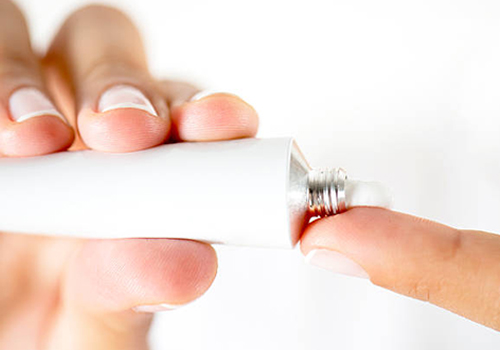Ointments

An ointment is a homogeneous, viscous, semi-solid preparation, most commonly a greasy, thick oil (oil 80% - water 20%) with a high viscosity, that is intended for external application to the skin or mucous membranes. Ointments have a water number that defines the maximum amount of water that they can contain. They are used as emollients or for the application of active ingredients to the skin for protective, therapeutic, or prophylactic purposes and where a degree of occlusion is desired.
Ointments are used topically on a variety of body surfaces. These include the skin and the mucous membranes of the eye (an eye ointment), chest, vulva, anus, and nose. An ointment may or may not be medicated.
Ointments are usually very moisturizing, and good for dry skin. They have a low risk of sensitization due to having few ingredients beyond the base oil or fat, and low irritation risk. There is typically little variability between brands of drugs. They are often disliked by patients due to greasiness.[9]
The vehicle of an ointment is known as the ointment base. The choice of a base depends upon the clinical indication for the ointment. The different types of ointment bases are:
Absorption bases, e.g., beeswax and wool fat
Emulsifying bases, e.g., cetrimide and emulsifying wax
Hydrocarbon bases, e.g., ceresine, microcrystalline wax, hard paraffin, and soft paraffin
Vegetable oil bases, e.g., almond oil, coconut oil, olive oil, peanut oil, and sesame oil
Water-soluble bases, e.g., macrogols 200, 300, 400
The medicaments are dispersed in the base and are divided after penetrating the living cells of the skin.
The water number of an ointment is the maximum quantity of water that 100g of a base can contain at 20 °C.
Ointments are formulated using hydrophobic, hydrophilic, or water-emulsifying bases to provide preparations that are immiscible, miscible, or emulsifiable with skin secretions. They can also be derived from hydrocarbon (fatty), absorption, water-removable, or water-soluble bases.
Evaluation of ointments:[citation needed]
Drug content
Release of medicament from base
Medicament penetration
Consistency of the preparation
Absorption of medicament into blood stream
Irritant effect
Properties which affect choice of an ointment base are:[citation needed]
Stability
Penetrability
Solvent property
Irritant effects
Ease of application and removal
Methods of preparation of ointments:
Fusion: In this method the ingredients are melted together in descending order of their melting points and stirred to ensure homogeneity.[citation needed]
Trituration: In this finely subdivided insoluble medicaments are evenly distributed by grinding with a small amount of the base followed by dilution with gradually increasing amounts of the base.[citation needed]

